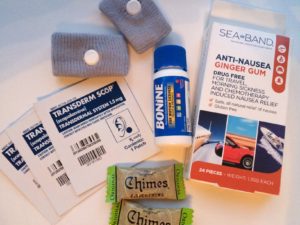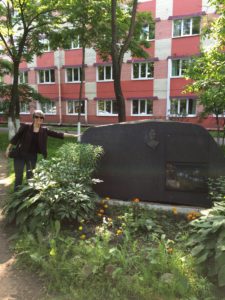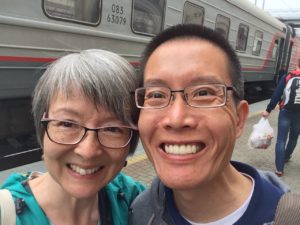
I’ve started composing this installment of my travel report aboard the Trans-Siberian Railway, late at night, someplace between Vladivostok and Khabarovsk.
I hope in a few days to be able to post something entertaining about this train trip, but tonight I’m going to tell you about the two-day/two-night ferry trip between Japan and Russia. This was the segment that occasioned the most anxiety for me before I set off from landlocked Davis, California.
For starters, it was the only part of the trip where I would be completely alone. My husband Dan and younger son Eliot accompanied me to Japan, and my very dear friend Chris met me in Vladivostok on Monday and will accompany me all the way to Paris. But on the ferry, I would be alone.
It would also be my first time ever at sea—by which I mean being in a vessel of some kind overnight and out of sight of land for hours at a time. This may surprise some of you who know me through my first book, Landfalls, which is about an ocean voyage. But except for a few half-day sailing excursions with my family in my teens, I’d never been out on the ocean at all.
I’ve always been fascinated by shipwreck stories. That fascination led to my first novel. It has not, however, exactly emboldened me to seek out shipboard experiences for myself.
Moreover, we’d be sailing right past North Korea. With all the saber-rattling lately between our two countries, this felt like a somewhat riskier proposition than in the past. If you’re not clear on the geography here, check out the map below.
[googlemaps https://www.google.com/maps/d/embed?mid=1SoWEx4n3su7LmraYUn5w0UgMUI0&hl=en&w=640&h=480]As I said, right past North Korea.
And then there was my acute fear of seasickness.
Ever since I was a small child, I’ve been phobic about vomiting. It’s a relatively common phobia, I understand. My emetophobia is so intense that it’s hard for me to even write about it. If this were someone else’s account instead of my own, I would start feeling queasy just reading it.
When Dan and I decided to have kids some twenty-odd years ago, honestly, my fear of morning sickness and children’s stomach ailments was among my biggest concerns. In fact, we proceeded only after he assured me that he would deal with all throw-up situations with the kids, and the man was good to his word. On at least two occasions, he left work in the middle of the day to rescue me.
But I digress.
The point is that the prospect of being stuck for upwards of forty hours on a boat ride that might make me sick left me shaky with anticipatory dread. Almost as bad was the prospect of being stuck with other people who were seasick. This for me was like a vision of hell.
These days one can easily fly from Japan to Vladivostok. I found some flights that weren’t all that expensive. (In fact, I just met a Japanese gentleman on the train who’d wanted to take the ferry I took but had flown instead, worried about the North Korea situation.)
But Akiko took the ferry, and I felt like I should also. It felt like “cheating” to do otherwise.
Akiko left from Tsuruga in Fukui Prefecture, once the gateway to Europe from Japan. She was seen off at the port by her publisher and by her eldest son Hikaru.

That ferry no longer runs, but DBS Cruise Ferry, a South Korean company, runs a weekly ferry, the Eastern Dream, along the route mapped out above—i.e., departing Sakaiminato, the port town in Tottori Prefecture, at 7 pm every Saturday evening; landing at Donghae, South Korea, Sunday morning around 9 am; departing again around 2 pm; and arriving in Vladivostok on Monday at 1 pm.
It wasn’t exactly Akiko’s itinerary, but it was as close as I could get.
There was just the small matter of being really, really afraid.
So I did what I not infrequently do when faced with a dilemma: I went to Facebook, described my problem, and solicited advice.
Facebook is good for this. People came from all across the globe and political spectrum to offer me encouragement and tips. Encouragement to go for it despite my apprehensions. Lots of tips for preventing or ameliorating seasickness. And permission to splurge—if it were available and I could afford it, which luckily it was and I could—on a private cabin with my own bathroom so that whatever I experienced or endured on the ferry I could do by myself.
 I went for it: I booked passage on the ferry and reserved a “junior suite.” It cost an unseemly amount of money, payable in Japanese yen only at the international ferry terminal in Sakaiminato. And I amassed an arsenal of anti-seasickness remedies: scopolamine patches, Bonine, Sea Bands, ginger chews, ginger gum.
I went for it: I booked passage on the ferry and reserved a “junior suite.” It cost an unseemly amount of money, payable in Japanese yen only at the international ferry terminal in Sakaiminato. And I amassed an arsenal of anti-seasickness remedies: scopolamine patches, Bonine, Sea Bands, ginger chews, ginger gum.
On Saturday, June 24, I said good-bye to Dan in Sakaiminato and boarded the ferry.
And you know what? I loved it.

I loved the Eastern Dream with its over-the-top “grand” staircase and whimsical murals. I loved the friendly, helpful staff, most of them young people from Korea or the Philippines. I loved the guy who was able to make announcements in Korean, Chinese, Japanese, Russian, and English. I loved the buffet-style meals. The food wasn’t Zagat-worthy, but it was all right, and the dining area had—well, ocean views. I loved the feel of the salt breeze when I walked out on deck. I loved the shipboard camaraderie, however temporary.

And most of all I loved Junior Suite 1, a surprisingly spacious cabin on Deck A, with its tiny bathroom that was mine and mine only, the large bed that felt like a box spring missing its mattress, and especially, especially, especially, the enormous window that looked out on the sea. It was overcast through much of the voyage, which made the sea look silvery-gray, like mercury.
Through that window I watched Japan recede in a light rain. I watched the ferry’s wake. I saw a shark swim past, dip down into the dark water, then surface again. I saw buoys placed miles and miles from anyplace, showing us the way. Who placed them there, I wondered, and at what cost? I saw Donghae, South Korea, drift suddenly into view the next morning. Nearly everyone on the ferry disembarked, even those going on to Vladivostok, but I used the solitude to charge up my devices on board and post my last blog update.

Then we sailed away from Donghae into choppier seas toward Russia. I was farther than I’d ever been from anything familiar to me. My phone said “No service”—not even roaming—for the rest of the passage. My cabin was on the starboard side; I knew that if I were on the other side, I’d be looking out my window, straining to see North Korea, wondering about the mysterious dark country past which we were sailing.
I loved the solitude. I’d been worried about being on my own, but once on board, I realized it would be the only period on the trip I’d have to myself, and I decided to enjoy it. I wrote a little. I revised a little. I read a little. I studied some Russian. I wrote in my journal. I took pictures. I walked around the ferry. I drank a little vodka some Russian passengers were sharing with other travelers.
A very nice staff member had carried my bag all the way to the top when I first arrived; I wasn’t sure if I was expected to, but I gave him a tip, and when I disembarked, he made sure someone came to collect me and my bags, escorting me past two decks of waiting passengers. My appearance seemed to inflame a shouting match in Korean between some disgruntled passengers and ferry staff who yelled right back.
 Best of all, I didn’t get sick. I didn’t even get queasy. I probably lucked out with a relatively smooth passage, although one shipboard acquaintance said he felt a bit nauseated during the second night. I’d applied every remedy: the scopolamine patch behind my right ear, sea bands on both wrists, a few ginger chews for good measure, a Bonine when the second night proved a bit choppier. But the truth is I actually enjoyed the movement of the ferry. It lulled me to sleep both nights. I slept quite well despite the springs I could feel right under my shoulder blades.
Best of all, I didn’t get sick. I didn’t even get queasy. I probably lucked out with a relatively smooth passage, although one shipboard acquaintance said he felt a bit nauseated during the second night. I’d applied every remedy: the scopolamine patch behind my right ear, sea bands on both wrists, a few ginger chews for good measure, a Bonine when the second night proved a bit choppier. But the truth is I actually enjoyed the movement of the ferry. It lulled me to sleep both nights. I slept quite well despite the springs I could feel right under my shoulder blades.
All in all, I’d say I had more fun on the ferry than Akiko did. Here’s one of the poems she wrote about her experience of sailing to Vladivostok on the Russian ferry Aureole:
わが泣けば露西亜少女来て肩なでぬアリヨル号の白き船室
Waga nakeba Roshia otome kite kata nadenu Ariyoru-gō no shiroki senshitsu
When I cried, a Russian girl
came and stroked my shoulder:
the white cabin
aboard the Aureole.

I was a little sad to leave the Eastern Dream. That’s been true of every destination of this trip so far. I’ve wished I could stay just a little longer in each place. This time I thought, if only I could stay here a couple more days, it would have been like a really cool writing residency. But we’d arrived in Vladivostok, and it was time to disembark.

Once I finally got through immigration and customs, the part of my trip I organized through the estimable MIR Corporation began. I was met by a guide, Darya, and a driver, Natasha, who took me to the Yosano Akiko memorial on the campus of Far Eastern Federal University. It includes an engraved likeness of Akiko, a brief description of her 1912 visit to Vladivostok, and her poem, “Tabi ni tatsu” (Leaving on a Trip), an unusual 12-line poem she composed as she set off on her journey. (I haven’t quite managed to translate this one yet, so won’t share it at this point.)
Darya was a terrific guide, and she was willing to take me to see a number of other sights in the city. But I was eager to check into the hotel and see Chris, who’d flown in early that morning and had likely been waiting for me all day.
Chris and I have been friends for almost 30 years, ever since we were not-particularly-satisfied grad students together in Stanford’s Asian Languages Department. We’re always happy to see each other. But there’s a special joy in meeting a friend halfway around the world, in a city where neither of you has ever been.
The next evening, we boarded the Trans-Siberian Railway.
I’m fascinated by this trip, and the poetry is growing on me, although I’ve never been drawn to that literary form.
Thanks so much for reading & taking the time to comment!
This is so much fun to read! Lucky for me, you subbed at Trivia one night and I met you. Even luckier is that I read “Landfalls” and you came to my book club meeting when we selected your book. Now I’m waiting for “Luckiest for me…” when I get to read the culmination of this adventure you’re having.
Aw, thanks, Pat! Lucky for me too in your friendship!
Wow, this is such an interesting trip. I’m glad you didn’t get sea-sick and had such a meaningful experience of the sea instead. Can’t wait to read entry 4.
Thanks so much, Mitty! I’m having a wonderful time.
I told you I have never seen you getting any kind of motion sickness….Glad to hear the ferry ride was so enjoyable!
It’s true, I’ve never gotten motion sickness before, but I was still nervous!